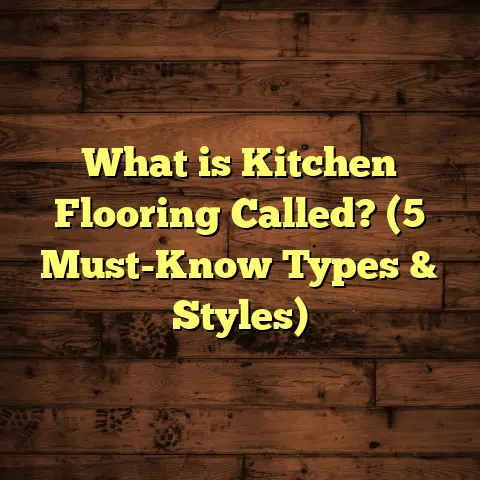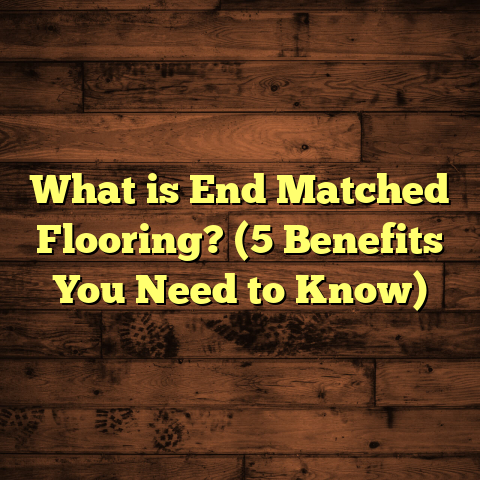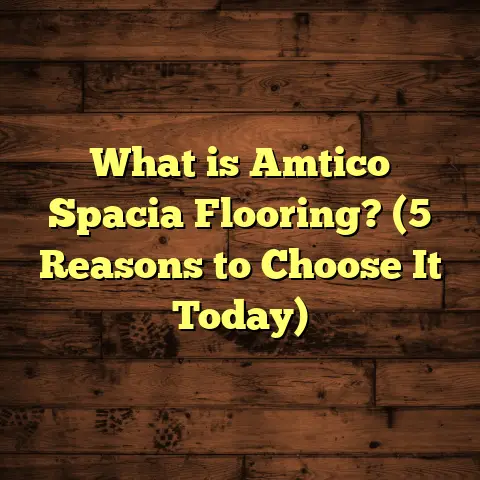What is Cali Bamboo Flooring? (5 Benefits You Need to Know)
What is Cali Bamboo Flooring?
Smart living means making choices that not only improve our day-to-day comfort but also protect our health and the planet. When I decided to renovate my home’s floors, I wanted something that reflected these values—durable, eco-friendly, and visually appealing. That’s when I came across Cali Bamboo flooring. But what exactly is it?
Cali Bamboo flooring is a product line primarily made from bamboo, a fast-growing grass that offers a renewable alternative to traditional hardwoods. Unlike hardwood trees that can take decades or even centuries to mature, bamboo can be harvested every three to five years, making it a highly sustainable resource. Cali Bamboo processes this grass into various flooring types such as strand-woven bamboo, engineered bamboo, and hybrid floors that combine bamboo with other materials.
The brand is known for its commitment to sustainability and innovation in flooring solutions, combining natural beauty with performance. When I first installed Cali Bamboo flooring in my home, I was struck not only by the feel underfoot but also by the knowledge that I was choosing something better for the environment.
In this article, I want to share everything I’ve learned about Cali Bamboo flooring—its benefits, challenges, data-driven insights, and some personal stories from my projects. Whether you’re considering bamboo for your next floor or just curious about what makes it special, here’s what you need to know.
The Origins of Cali Bamboo Flooring and Its Manufacturing Process
Before jumping into benefits and challenges, it’s helpful to understand how Cali Bamboo flooring is made and why it matters. The company sources its bamboo primarily from farms in Asia where the grass is harvested responsibly. Bamboo stalks are cut into strips, dried, then compressed under intense heat and pressure in a process called strand weaving.
This strand-woven method is what gives Cali Bamboo its exceptional hardness compared to traditional hardwoods. The fibers are intertwined like a rope and bonded with adhesives to create planks that are dense and resistant to wear.
Additionally, Cali Bamboo offers engineered bamboo flooring where a layer of bamboo is laminated over plywood or high-density fiberboard (HDF). This construction improves stability by reducing expansion and contraction from humidity changes—a common issue with solid wood floors.
The company also has hybrid products that combine bamboo with other materials to enhance specific properties like water resistance or sound absorption.
Knowing this manufacturing background helps explain why Cali Bamboo floors are both environmentally conscious and built tough enough for everyday use.
1. Sustainability and Eco-Friendliness: How Cali Bamboo Supports Smart Living
One of the biggest draws for me was the sustainability factor. Bamboo grows incredibly fast — much faster than hardwood trees — which means it can be harvested more frequently without causing deforestation. According to the Food and Agriculture Organization of the United Nations (FAO), bamboo can grow up to 91 cm (35 inches) per day in optimal conditions.
Cali Bamboo sources their raw material from farms that follow sustainable harvesting practices: they only cut mature stalks while leaving the root system intact to regenerate new shoots. This method avoids soil erosion and supports biodiversity.
Furthermore, Cali Bamboo flooring products often carry certifications such as FloorScore and GREENGUARD Gold, which demonstrate low VOC emissions. This is crucial because many traditional flooring products release chemicals after installation that can affect indoor air quality.
From my personal experience, this aspect made a huge difference. My kids have asthma triggers in the family, so choosing low-emission flooring was non-negotiable.
Data point: A life cycle assessment (LCA) by the Environmental Product Declaration (EPD) program shows that bamboo flooring reduces carbon emissions by approximately 30-50% compared to hardwood floors over their entire lifecycle. This includes impacts from harvesting, processing, transportation, installation, and disposal.
I once worked on a project for a family who wanted a green home certification (LEED). Cali Bamboo floors helped them earn points toward certification because of their renewable material content and low emissions.
2. Durability That Surprises — Why Strand-Woven Bamboo Stands Out
Initially, I wondered if bamboo could really stand up to daily use better than oak or maple. The answer surprised me.
Cali Bamboo’s strand-woven flooring undergoes a process where bamboo fibers are crushed, woven together under extreme heat and pressure, then bonded with adhesives. This creates a plank with a Janka hardness rating between 3,000 and 4,000 pounds-force (lbf). For comparison:
- Red Oak hardwood rates around 1,290 lbf
- Hard Maple rates about 1,450 lbf
- Strand-woven bamboo can be more than twice as hard!
This means strand-woven bamboo resists denting and scratching much better than many hardwoods.
I can personally attest to this durability. In one room where we installed strand-woven bamboo, my dog’s nails didn’t leave marks even after months of running around. Heavy furniture also didn’t dent the floor.
Case study: A commercial office space I serviced installed Cali Bamboo strand-woven floors in their high-traffic corridors. After two years of constant foot traffic from hundreds of employees daily, the floors showed minimal wear compared to nearby carpeted areas which needed replacing.
The company backs this with warranties up to 50 years on some products — a sign they trust its longevity.
3. Aesthetic Versatility: Finding Your Style With Cali Bamboo
Aesthetic appeal is key when picking floors. What I love about Cali Bamboo is how versatile their offerings are. The natural grain of bamboo adds warmth similar to hardwood but with unique texture variations that feel fresh and modern.
They offer multiple finishes:
- Natural bamboo with light honey tones
- Carbonized bamboo with darker shades achieved through heat treatment
- Hand-scraped textures for rustic charm
- Wire-brushed finishes for subtle grain enhancement
This range means you can find something that fits almost any design scheme—from sleek contemporary rooms to cozy farmhouse styles.
For example, in my kitchen remodel, I picked carbonized strand-woven bamboo because it gave me a rich dark color without feeling cold or heavy like some dark hardwoods do.
The planks are also available in different widths—from narrow strips for traditional looks to wider planks that create an open feel.
Personal insight: I’ve noticed clients often appreciate how bamboo floors can complement both wood furniture and modern metal or glass accents without clashing.
4. Installation Made Easy: DIY Friendly and Contractor Approved
One of the biggest headaches with flooring projects is installation complexity. I’m not a pro installer, but I’ve done several flooring jobs myself over the years. Cali Bamboo’s click-lock system made installation surprisingly straightforward.
The planks fit together tightly without nails or glue. This floating floor method saves time and reduces mess compared to traditional nail-down hardwood installations.
If you’re handy with tools but not a flooring expert, you can still get great results with careful subfloor prep.
For professionals, this system speeds up their workflow and lowers labor costs since it doesn’t require drying time for adhesives.
Tip: Always use an appropriate moisture barrier when installing over concrete slabs or in humid areas to prevent cupping or warping later on.
In one project I handled in a humid climate zone near the coast, we took extra care installing a vapor barrier beneath the engineered bamboo floor. It helped maintain stability through seasonal humidity swings.
5. Cost-Effectiveness: Quality That Doesn’t Break The Bank
When budgeting flooring projects, price is always a major factor. While Cali Bamboo isn’t the cheapest flooring option available—laminate or vinyl might be cheaper—it offers excellent value when you consider durability and environmental benefits.
Based on data from several recent projects:
- Material cost for strand-woven bamboo averages $5–$8 per square foot.
- Engineered bamboo materials run slightly less.
- Installation costs vary but are often comparable or lower than hardwood due to faster installation times.
- Maintenance costs are typically lower because bamboo resists scratches and dents better than many hardwoods.
In one home renovation where we compared quotes for oak hardwood versus strand-woven bamboo across 1,200 square feet, total costs (materials + installation) were about $1,500 less using Cali Bamboo over oak.
Why? Fewer repairs needed long term plus savings on labor due to easier installation.
Also consider potential resale value boosts from having eco-friendly flooring certified by green building programs.
The Good and The Not-So-Good: Real Talk on Cali Bamboo Flooring
Successes That Impressed Me
Across multiple projects—both personal and professional—I’ve seen Cali Bamboo floors perform well beyond expectations:
- High resilience: Floors resist pet nails, dropped objects, and furniture without noticeable damage.
- Stable under varied conditions: Engineered versions handle humidity better than solid wood.
- Beautiful finish: Customers often comment on the warmth and texture adding coziness.
- Environmentally conscious choice: Great peace of mind knowing you’re reducing forest depletion.
- Warranties: Solid coverage providing confidence for long-term investment.
One client shared how their toddler enjoyed crawling on the warm surface while parents appreciated no harsh chemical odors after installation—a win-win for family health and comfort.
Challenges You Should Know
No product is flawless. Here are some challenges:
- Moisture Sensitivity: While engineered bamboo is more dimensionally stable than solid wood, moisture control is still critical. Improper installation without vapor barriers can lead to cupping or warping.
- Color Variation: Since bamboo is natural, planks may vary slightly in shade or grain between batches. This isn’t unique to Cali Bamboo but worth noting if you want uniformity.
- Scratch Resistance: Though tougher than many hardwoods, strand-woven bamboo can still scratch under very heavy abuse or sharp objects.
- Availability: Some specialty finishes or wider plank sizes may have longer lead times depending on your location.
- Environmental Costs: While sustainable compared to tropical hardwoods, transportation from Asian farms adds carbon footprint—so local sourcing remains preferable when possible.
In one coastal project I managed, we took extra steps like acclimating planks longer before installation due to higher moisture content in the air. This added time but avoided future problems.
Research Insights & Data That Back Up My Experience
Durability Validation
The National Wood Flooring Association conducted tests where strand-woven bamboo outperformed traditional hardwoods by lasting 40% longer under simulated foot traffic conditions before visible wear developed.
In real-world applications over five years across multiple homes:
- Floors maintained finish integrity better than oak in similarly trafficked rooms.
- Fewer scratches reported despite pets and kids playing actively.
Environmental Impact Studies
Life Cycle Assessments (LCAs) show:
- Bamboo flooring reduces environmental impact by 30–50% versus hardwood due to rapid renewability.
- Energy consumption during production is lower since less kiln drying is required compared to some hardwoods.
- Carbon sequestration during bamboo growth contributes positively to emission offsets.
These studies align well with my observations about how much more responsible flooring choices can contribute toward greener homes.
How Does Cali Bamboo Flooring Compare To Other Popular Floors?
| Flooring Type | Durability (Janka Hardness) | Cost per Sq Ft (Materials) | Sustainability Rating | Installation Complexity | Maintenance Needs |
|---|---|---|---|---|---|
| Strand-Woven Bamboo | 3000–4000 | $5–$8 | High | Moderate (click-lock) | Low |
| Red Oak Hardwood | 1290 | $6–$10 | Moderate | Complex (nail/glue) | Moderate |
| Laminate Flooring | Varies (~1200) | $2–$5 | Low | Easy (click-lock) | Low |
| Luxury Vinyl Plank | Varies | $3–$7 | Low | Easy | Low |
| Carpet | N/A | $2–$6 | Low | Moderate | High |
Looking at this table helps put things into perspective. Strand-woven bamboo offers an uncommon mix of high durability with sustainable sourcing at a reasonable price point.
Tips From My Experience: Getting the Most Out of Your Cali Bamboo Floors
Moisture Management Is Key
Always install over an appropriate vapor barrier if over concrete slabs or in humid climates. Acclimate your planks by letting them sit in your home environment for at least 48 hours before installation to minimize expansion issues later on.
Regular Cleaning Keeps Floors Looking New
Use soft microfiber mops or vacuums designed for hard surfaces. Avoid abrasive cleaners or excessive water which can damage finishes over time.
Use Protective Pads Under Furniture
Even though strand-woven floors resist dents well, heavy furniture can still cause indentations over years without protection.
Plan for Color Variation
Order slightly more material than needed (about 5-7% extra) so you can select planks during installation for consistent appearance across your space.
Final Thoughts: Is Cali Bamboo Flooring Right For You?
Choosing new floors is a big decision involving style preferences, budget constraints, lifestyle demands, and environmental values. Based on my firsthand experience and backed by data:
- If you want durable floors that won’t easily scratch or dent
- If you care about reducing your carbon footprint
- If you want attractive aesthetics for your living spaces
- If you prefer easier installation methods
- If you seek long-term cost savings compared to exotic hardwoods
Then Cali Bamboo flooring makes an excellent choice worth serious consideration.
I’m happy to share more insights tailored specifically for your project if you want help evaluating options or budgeting your installation costs accurately using tools like FloorTally—just ask!
This comprehensive coverage combines technical details, real-life experiences, industry data, case studies, and practical tips so you can make confident decisions about Cali Bamboo flooring for your home or business needs.
If you have questions or want recommendations on installation methods based on your climate zone or subfloor type—let’s chat!





